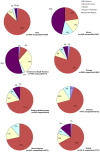Childhood intussusception: a literature review
- PMID: 23894308
- PMCID: PMC3718796
- DOI: 10.1371/journal.pone.0068482
Childhood intussusception: a literature review
Abstract
Background: Postlicensure data has identified a causal link between rotavirus vaccines and intussusception in some settings. As rotavirus vaccines are introduced globally, monitoring intussusception will be crucial for ensuring safety of the vaccine programs.
Methods: To obtain updated information on background rates and clinical management of intussusception, we reviewed studies of intussusception in children <18 years of age published since 2002. We assessed the incidence of intussusception by month of life among children <1 year of age, seasonality, method of diagnosis, treatment, and case-fatality.
Findings: We identified 82 studies from North America, Asia, Europe, Oceania, Africa, Eastern Mediterranean, and Central & South America that reported a total of 44,454 intussusception events. The mean incidence of intussusception was 74 per 100,000 (range: 9-328) among children <1 year of age, with peak incidence among infants 5-7 months of age. No seasonal patterns were observed. A radiographic modality was used to diagnose intussusception in over 95% of the cases in all regions except Africa where clinical findings or surgery were used in 65% of the cases. Surgical rates were substantially higher in Africa (77%) and Central and South America (86%) compared to other regions (13-29%). Case-fatality also was higher in Africa (9%) compared to other regions (<1%). The primary limitation of this review relates to the heterogeneity in intussusception surveillance across different regions.
Conclusion: This review of the intussusception literature from the past decade provides pertinent information that should facilitate implementation of intussusception surveillance for monitoring the postlicensure safety of rotavirus vaccines.
Conflict of interest statement
Figures







References
-
- Bines JE, Kohl KS, Forster J, Zanardi LR, Davis RL, et al. (2004) Acute intussusception in infants and children as an adverse event following immunization: case definition and guidelines of data collection, analysis, and presentation. Vaccine 22: 569–574. - PubMed
-
- Bines JE, Patel M, Parashar U (2009) Assessment of postlicensure safety of rotavirus vaccines, with emphasis on intussusception. J Infect Dis 200 Suppl 1S282–290. - PubMed
-
- WHO (2002) Acute intussusception in infants and children. Incidence, clinical presentation and management: a global perspective. Geneva: World Health Organization. Document WHO/V & B/02 (19) 1–98.
-
- Murphy TV, Gargiullo PM, Massoudi MS, Nelson DB, Jumaan AO, et al. (2001) Intussusception among infants given an oral rotavirus vaccine. N Engl J Med 344: 564–572. - PubMed
-
- Patel MM, Haber P, Baggs J, Zuber P, Bines JE, et al. (2009) Intussusception and rotavirus vaccination: a review of the available evidence. Expert Rev Vaccines 8: 1555–1564. - PubMed
Publication types
MeSH terms
LinkOut - more resources
Full Text Sources
Other Literature Sources
Medical
Research Materials
Miscellaneous

